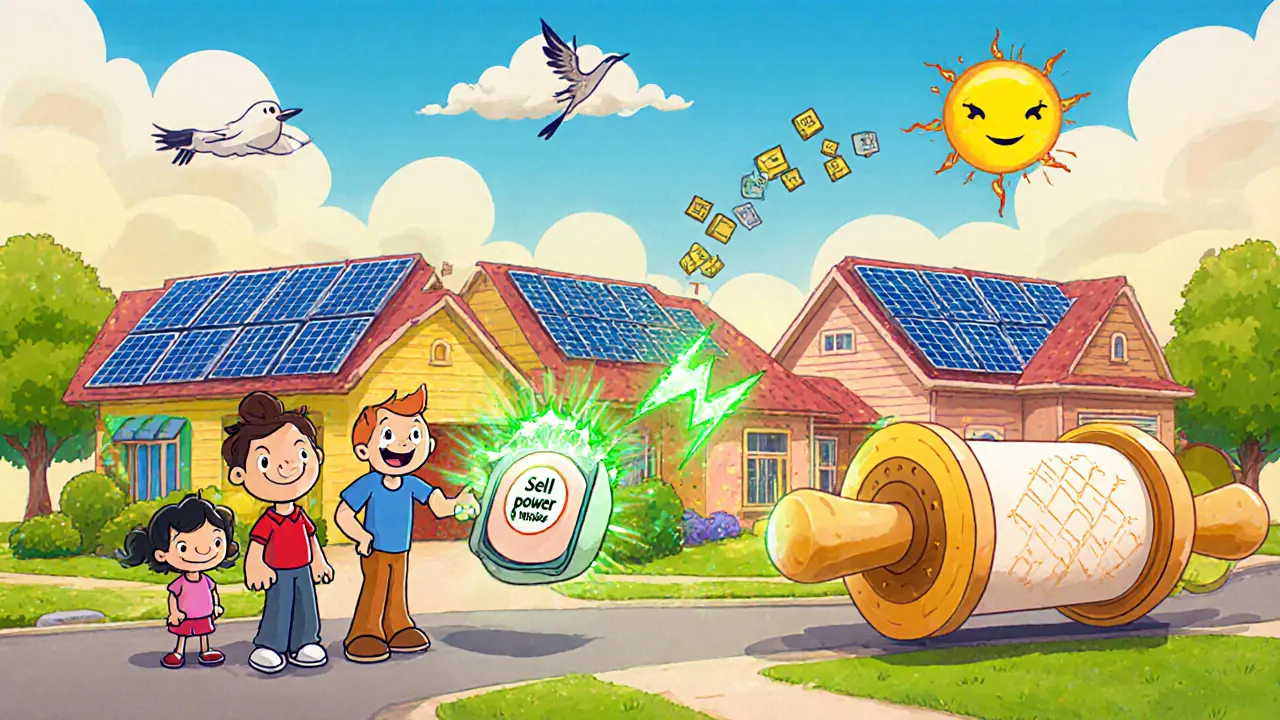Blockchain Energy Market Forecast Calculator
Projected Market Value
Enter values and click Calculate to see projection
2025 Forecast
$6.43B
Projected global market size
Growth Rate
30%
CAGR expected
Regional Share
35%
Europe's market share
Imagine a world where households sell excess solar power to neighbors with a single click, where carbon credits are verified instantly on a tamper‑proof ledger, and where grid operators balance supply and demand without human error. That vision is already taking shape thanks to blockchain energy solutions that combine decentralized ledgers, artificial intelligence, and new modular architectures. This article walks you through the market momentum, the technology that makes it possible, real‑world projects that are proving the concept, and the hurdles you’ll need to overcome to make the future a reality.

Key Takeaways
- The global blockchain‑in‑energy market is forecast to exceed $6.43billion by 2025, driven by private‑chain deployments and energy‑trading platforms.
- Modular blockchain designs - such as Celestia and Polygon 2.0 - solve scalability and compliance problems that stymied early projects.
- Six use cases - P2P trading, carbon‑credit tokenization, green crypto mining, smart‑grid automation, tokenized assets, and battery‑lifecycle tracking - have moved from pilots to commercial roll‑outs.
- Environmental concerns are being addressed through proof‑of‑stake, zero‑knowledge proofs, and AI‑enhanced smart contracts that cut energy use.
- Adopters need a clear roadmap: start with a private consortium, pick a modular layer, integrate AI analytics, and align with emerging regulations.
Market Landscape: Size, Growth, and Regional Leaders
The blockchain‑energy market has left the experimental stage. In 2023 the sector was valued at roughly $3billion; by 2025 it’s projected to surpass $6.43billion, a compound annual growth rate above 30%.
Geographically, Europe commands the largest share - around 35% of global revenue (≈$1.94billion). Strong policy support for renewable integration and a dense network of utilities have accelerated adoption. North America follows at 16% share, while Asia‑Pacific accounts for 14%, led by China’s massive renewable‑capacity investments and Singapore’s innovation grants.
Private blockchains dominate, holding about 65% of deployments. Energy‑trading platforms make up roughly 30% of applications, with the remainder spread across grid management, asset tokenization, and compliance reporting.
Technical Foundations: Modular Blockchains and AI Integration
Early blockchain projects struggled with monolithic designs where consensus, execution, and data availability lived on the same chain. That caused bottlenecks, especially when handling high‑frequency energy data.
Today, modular blockchain architecture separates these layers:
- Consensus layer - often proof‑of‑stake (PoS) or a hybrid PoS/PoA model, delivering fast finality with low energy draw.
- Execution layer - smart‑contract engines customized for energy‑specific logic, such as time‑of‑use pricing or demand‑response triggers.
- Data‑availability layer - services like Celestia provide scalable, verifiable storage without burdening every node.
Polygon 2.0’s multichain coordination and EigenLayer’s re‑staking mechanism let startups launch execution environments in weeks rather than years, slashing infrastructure costs by up to 70%.
Artificial intelligence now powers several critical functions:
- Predictive analytics feed smart contracts with demand forecasts, reducing mismatches.
- AI‑driven fraud detection flags anomalous trades before they settle on‑chain.
- Machine‑learning optimizes gas‑price calculations for energy‑token transactions, keeping fees predictable.
Real‑World Use Cases Gaining Traction
Six applications have crossed the proof‑of‑concept threshold and are delivering measurable benefits.
| Use Case | Primary Benefit | Typical Stakeholders | Notable Example |
|---|---|---|---|
| Peer‑to‑Peer Energy Trading | Direct monetization of surplus solar | Homeowners, local utilities, aggregators | PowerLedger (Australia) |
| Carbon Credit Tokenization | Instant, verifiable credit transfer | Farmers, ESG funds, regulators | Veridium (USA) |
| Green Crypto Mining | Monetize excess renewable generation | Developing‑nation utilities, miners | SolarMine (Kenya) |
| Smart Grid Automation | Real‑time load balancing, outage prediction | Grid operators, IoT sensor vendors | Sinergia Grid (Germany) |
| Tokenized Energy Assets | Micro‑investment in solar farms | Retail investors, project developers | EnergyCoin (Spain) |
| Battery Lifecycle Tracking | Transparent recycling, second‑life markets | Manufacturers, recyclers, policymakers | ReCharge Chain (Netherlands) |
Each case leverages a core set of blockchain capabilities - immutability, automated settlement via smart contracts, and decentralized identity - to solve a specific pain point that traditional systems can’t address efficiently.
Challenges and Sustainability Concerns
Despite the upside, several obstacles still need attention:
- Energy Consumption: Proof‑of‑Work networks still consume megawatts of power. The industry is shifting to PoS and zero‑knowledge proof (ZKP) roll‑ups, cutting energy use by up to 99%.
- Regulatory Fragmentation: Europe’s MiCA framework, the U.S. SEC’s stance on digital assets, and Singapore’s Innovation Act create a patchwork of rules. Companies must build compliance layers into their smart contracts.
- Interoperability: Multiple modular chains mean data formats differ. Standards bodies like the International Energy Agency (IEA) are drafting cross‑chain protocols to enable seamless asset transfer.
- Skill Gaps: Deploying a modular blockchain stack requires expertise in cryptography, distributed systems, and energy market regulations. Talent shortages are driving partnerships with specialized consultancies.
Roadmap: What 2026‑2030 Could Look Like
Industry analysts agree that the next five years will see three major shifts:
- From Pilot to Production: More utilities will migrate P2P platforms from sandbox environments into live markets, backed by national regulators.
- Integrated AI‑Blockchain Platforms: AI modules will become native services on modular layers, offering out‑of‑the‑box demand forecasting and dynamic pricing.
- Global Carbon‑Credit Networks: Tokenized credits will be linked across borders, enabling firms to offset emissions in real time through a single interoperable ledger.
By 2030, it’s plausible that half of all renewable‑energy transactions in Europe will settle on a blockchain, and battery‑lifecycle data will be auditable by regulators worldwide.
Practical Checklist for Energy Companies Ready to Adopt Blockchain
- Define the business problem - e.g., reducing settlement time, enhancing transparency, opening new revenue streams.
- Select a modular architecture - consider Celestia for data availability, Polygon 2.0 for multi‑chain support.
- Start with a private consortium - limit exposure while you build governance rules.
- Integrate AI analytics early - use predictive models to feed smart contracts with accurate demand data.
- Plan for compliance - map your jurisdiction’s reporting requirements into on‑chain audit trails.
- Pilot with a single use case - P2P trading or carbon‑credit tokenization are low‑risk entry points.
- Scale gradually - add more participants and public‑chain bridges once the private network proves stable.

Frequently Asked Questions
How does blockchain improve transparency in energy markets?
Every transaction - from solar generation to carbon‑credit issuance - is recorded on an immutable ledger that all participants can view in real time. Auditors can trace the origin of a kilowatt‑hour or a credit without needing a central intermediary.
Are proof‑of‑stake blockchains safe enough for critical energy infrastructure?
Yes. PoS consensus combines economic staking with slashing penalties that discourage malicious behavior. Leading energy pilots (e.g., Germany’s Sinergia Grid) have run PoS‑based smart‑grid controllers for over a year with zero security incidents.
What’s the cost difference between building a private blockchain versus using a public network?
Private chains avoid transaction fees and can be tuned for latency, but they require hardware, node operation, and ongoing governance. Public PoS networks charge minimal gas (often <$0.001 per transaction). Modular approaches let you blend both - keep sensitive data private while publishing settlement hashes on a public chain for auditability.
How do regulatory bodies view tokenized carbon credits?
Regulators are moving toward acceptance. The EU’s Market‑Based Mechanism now recognizes blockchain‑verified credits if the underlying project meets the EU Taxonomy. In the U.S., the SEC treats tokenized credits as securities only when they represent ownership in a specific project, not as generic offsets.
Can blockchain help with battery recycling?
Yes. By assigning a unique token to each battery cell at manufacture, stakeholders can track its state‑of‑health, ownership transfers, and final disposal. This data feeds into circular‑economy platforms that reward recyclers with micro‑payments.

Frequently Asked Questions
How does blockchain improve transparency in energy markets?
Every transaction - from solar generation to carbon‑credit issuance - is recorded on an immutable ledger that all participants can view in real time. Auditors can trace the origin of a kilowatt‑hour or a credit without needing a central intermediary.
Are proof‑of‑stake blockchains safe enough for critical energy infrastructure?
Yes. PoS consensus combines economic staking with slashing penalties that discourage malicious behavior. Leading energy pilots (e.g., Germany’s Sinergia Grid) have run PoS‑based smart‑grid controllers for over a year with zero security incidents.
What’s the cost difference between building a private blockchain versus using a public network?
Private chains avoid transaction fees and can be tuned for latency, but they require hardware, node operation, and ongoing governance. Public PoS networks charge minimal gas (often <$0.001 per transaction). Modular approaches let you blend both - keep sensitive data private while publishing settlement hashes on a public chain for auditability.
How do regulatory bodies view tokenized carbon credits?
Regulators are moving toward acceptance. The EU’s Market‑Based Mechanism now recognizes blockchain‑verified credits if the underlying project meets the EU Taxonomy. In the U.S., the SEC treats tokenized credits as securities only when they represent ownership in a specific project, not as generic offsets.
Can blockchain help with battery recycling?
Yes. By assigning a unique token to each battery cell at manufacture, stakeholders can track its state‑of‑health, ownership transfers, and final disposal. This data feeds into circular‑economy platforms that reward recyclers with micro‑payments.

Honestly, the whole blockchain‑energy hype feels like a marketing ploy. Most projects ignore the messy reality of grid regulation.
The US is *the* real trailblazer in blockchain‑energy, and anyone who says otherwise is just clueless. Stop whining about other countries and watch us dominate.
Everyone loves to shout about decentralization, but the truth is central utilities will still call the shots. Decentralized tokens won’t magically fix legacy infrastructure.
Hey folks, let's keep the conversation constructive. There are genuine pilots showing real savings, and that's where we should focus.
Oh great, another whitepaper promising to save the planet with blockchain. Because we all know that endless tokenization solves climate change.
It would be prudent to consider both the technical feasibility and regulatory compliance when evaluating blockchain solutions for energy markets.
Blockchain presents a compelling avenue for enhancing transparency within energy transactions, and this transparency can foster greater trust among participants.
By immutably recording generation and consumption data, stakeholders gain a clear audit trail that mitigates fraud.
Moreover, smart contracts enable automated settlement, reducing administrative overhead and accelerating payments.
The integration of renewable certificates onto a distributed ledger can simplify verification processes and reduce double‑counting.
From a consumer perspective, peer‑to‑peer energy trading platforms empower households to monetize excess generation, promoting democratization of the grid.
Utilities, on the other hand, can leverage aggregated ledger data to optimize load balancing and forecast demand more accurately.
Regulators may appreciate the ability to monitor emissions in real time, aligning with broader sustainability goals.
However, scalability remains a critical technical challenge; current blockchain throughput may not satisfy high‑frequency meter readings.
Energy‑grade consensus mechanisms, such as proof‑of‑authority, are being explored to address latency concerns while maintaining security.
Interoperability standards are essential to ensure that diverse grid assets can communicate seamlessly across blockchain networks.
Investment in robust cybersecurity measures is also non‑negotiable, given the heightened risk profile of critical infrastructure.
Collaboration between tech firms, utilities, and policymakers will be pivotal in crafting viable deployment roadmaps.
Pilot projects in Europe and North America have already demonstrated modest cost savings and operational efficiencies.
These early successes suggest a pragmatic pathway forward, contingent on addressing regulatory ambiguities.
Ultimately, the convergence of blockchain with the energy sector could catalyze a more resilient, transparent, and citizen‑centric energy ecosystem.
I’m curious how community solar projects could mesh with token incentives; any thoughts?
We must stop commodifying clean energy as a speculative asset! 🌍💔 If we keep chasing profits, the planet will pay the price.
There’s a vivid tapestry of use‑cases emerging-from micro‑grids in remote villages to carbon credit tracking-each thread adds richness to the overall narrative.
Look, the hype train is out of control. All these “use cases” sound like buzzwords ripped from a marketing deck.
Yo, I think we’re missing the point that blockchain can actually *help* with demand response, not just tokenizing electricity.
People need to stop navel‑gazing and think about real‑world integration.
Understanding the human side of energy transition is vital; technology alone won’t drive adoption without community buy‑in.
Scalability and regulatory clarity are the two biggest hurdles right now.
From a policy perspective, aligning blockchain incentives with existing renewable portfolio standards could streamline compliance and foster broader participation.
They’re hiding the truth. The big energy firms are using blockchain to track us, not to help the planet.